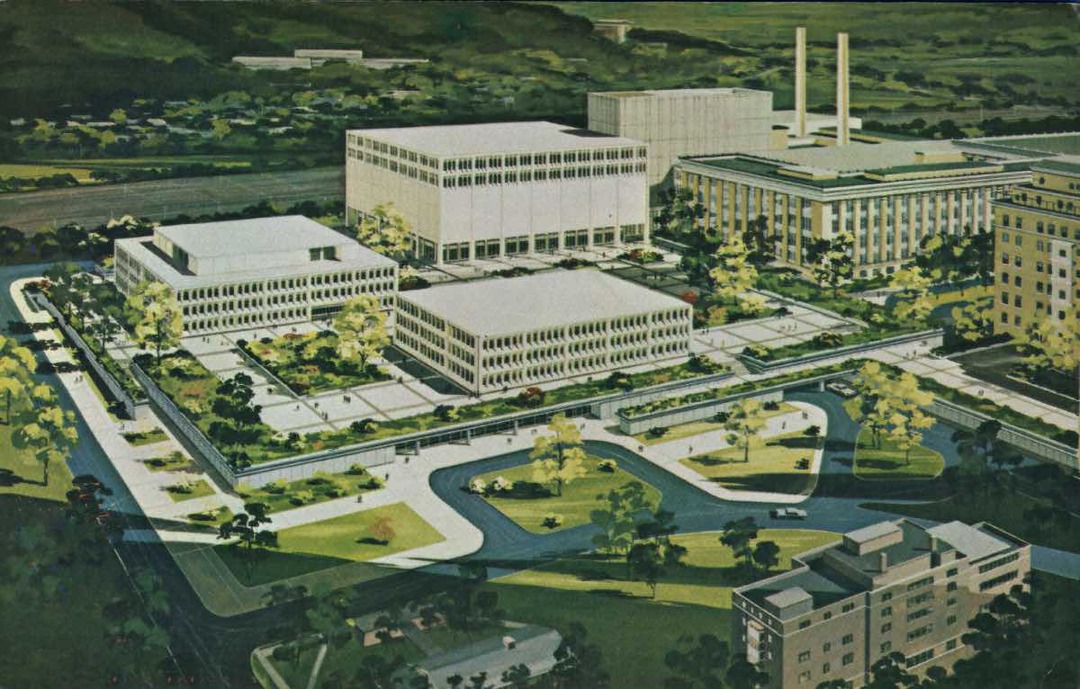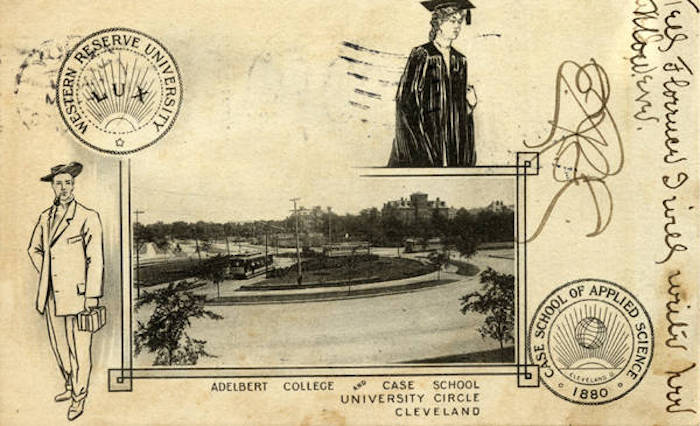
Two colleges growing in parallel through the nineteenth century achieved a cooperative union in 1967 and emerged as a premier educational institution in Cleveland and beyond.
Case Western Reserve University traces its roots to Western Reserve College, founded in Hudson, Ohio, in 1826. Three faculty members began instruction in theology, ancient languages, and mathematics/natural philosophy and began to graduate students in 1830. Western Reserve grew up in Hudson through national economic hardships and many political and academic challenges. Abolitionism, the Civil War, and the education of women were among the issues that shaped the College in the mid to late 19th century. Presidents George Pierce, Henry Hitchcock, and Carroll Cutler guided the development and logistics of Western Reserve’s curriculum, facilities, and finances from 1834 to 1886. The Cleveland Medical College was founded in 1843 in downtown Cleveland as an autonomous department of Western Reserve College. Among the growth in faculty during this time, Edward Morley was appointed as a Professor of Chemistry in 1869 (remaining until 1906) as a leader in chemistry and physics instruction. Economic and population growth in northern Ohio encouraged the school’s leaders to consider the metropolitan area and its resources for a relocation of the College from Hudson to Cleveland. Industrialist Amasa Stone financed the college’s move to Cleveland’s University Circle in 1880. The College moved its programs to newly constructed buildings along Euclid Avenue adjacent to the Case School of Applied Science and within six years established Adelbert College (for men), the College for Women and embraced affiliation with Music and Art programs in the locale.
The Case School of Applied Science was the brainchild of philanthropist Leonard Case, Jr. He financed the founding of the school in 1880 originally holding classes in the family home near Cleveland’s Public Square until construction of buildings along Glenwood Street (later becoming East Boulevard, then Martin Luther King Drive) in University Circle were completed. Western Reserve and Case became neighbors in 1882, and the schools began to share relationships through faculty research and program cooperation. CWRU historian, C. H. Cramer noted that in 1880, “the two schools agreed on ‘friendly cooperation’ —and for some time there was good will and good spirit between the institutions.” A fire at Case Main building prompted Adelbert College to provide rooms and equipment for Case programs. One of the first appointments to the Case faculty was physicist Albert Michelson. The two schools’ relationship became the setting for the groundbreaking Michelson-Morley Experiment, an 1887 study which laid the groundwork for modern theories of physics involving the measurement of light. Four presidents: Cady Staley, Charles Howe, William Wickenden, and T. Keith Glennan guided Case School Applied Science into Case Institute of Technology by 1947. Increased cooperation and federation with Western Reserve University from 1886 to 1966 was evident despite faculty, student, and alumni resistance to any discussions of an institutional merger.
Meanwhile, WRU continued growing through the decades and into the 20th century with the addition of Schools of Law, Dentistry, Graduate Programs, Pharmacy, Applied Social Sciences, Nursing, Education, Architecture, Business/Management, and Library Science by 1941. Cleveland College of Western Reserve University (and affiliated with Case) was established on Public Square in the Chamber of Commerce Building to provide downtown access to programs during days and evenings. At Case, under President Wickenden, the curriculum was molded to include humanities as part of the engineering program. Also notable was the admission of women into undergraduate programs in the sciences at Case during 1943 to bolster the Army and Navy workforce during the war. Women continued to earn degrees through 1954 when admissions ceased until 1960 at which time women were welcomed to all science and engineering programs permanently. Upon the aftermath of World War II, Keith Glennan, a businessman, assumed the presidency of Case Institute of Technology. He guided an era of unprecedented growth and expansion of the school and its programs via newfound support from foundations and government contracts. Glennan twice used leaves of absence to join the Atomic Energy Commission and to head NASA during his tenure which expanded his university’s exposure and engagement. Glennan also endorsed the notion that engineers and technologists needed to broaden their knowledge of human and social behavior and, consequently, expanded the curricula to that end. He noted that one economical method to implement this educational approach was to federate with “the complementary institution that was within eyesight of the Case administration building.” Glennan was also influenced by the merger of Fenn College of Engineering with Cleveland State University which eliminated a private engineering school in Cleveland and by the insights of the Carnegie Foundation president John Gardner concerning the advantages of a merged university in Cleveland. He and WRU president John Millis began regular meetings to discuss the possibilities of a federation or merger and sought consultant studies and expert input concerning the prospect.
The name Case Western Reserve University was derived from the merger of Western Reserve University and Case Institute of Technology. The process culminated a year-long administrative consolidation after both institutions' trustees’ approved merger plans. The plan required equal partnership and status of Case and WRU, despite their respective size differences and renewed vocalized resistance by faculty and alumni. Robert Morse succeeded Glennan as president of Case on July 1, 1966, and one year later became president of Case Western Reserve University. Eight more presidents would lead the institution through 2017 which marked the 50th anniversary of the merger and a celebration of the benefits and growth of the University and its developmental impact upon the University Circle region of Cleveland.
Audio
Images











